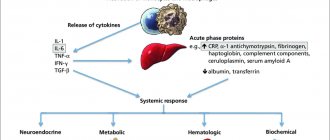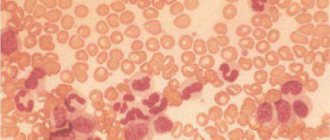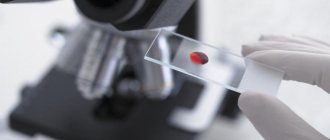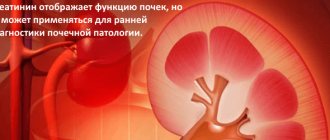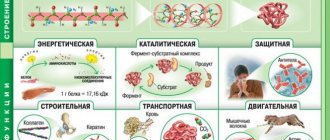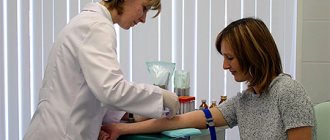What it is?
C-reactive protein (CRP) is an indicator of acute inflammation. It is produced by the liver, and this is done during necrotic and inflammatory processes in any part of the body. In clinical diagnostics, it is used along with ESR, but has higher sensitivity.
Reactive protein can only be detected using a biochemical blood test. It increases in the blood within 6-12 hours from the onset of the pathological process. CRP responds well to therapeutic methods, which makes it possible to monitor the progress of treatment using a simple analysis.
In contrast to ESR, C-reactive protein returns to normal values immediately after inflammatory processes have resolved and the patient’s condition has normalized. High ESR values, even after successful treatment, can persist for a month or more.
Action of C reactive protein (protein)
Why is analysis needed?
Sometimes parents have questions about the need and advisability of testing for reactive protein. As mentioned above, this protein is a kind of indicator of pathology, since it is the first to respond to changes in the body, and in the transcript of the analysis, the doctor sees an increase in C-reactive protein in the child. Modern laboratory diagnostic methods are highly accurate and sensitive, so they can detect even a slight increase in CRP. Accurate and correct interpretation of research results is important for medical diagnosis of various serious diseases of an infectious nature. The doctor prescribes a test if an individual has signs indicating illness. In addition, such a study is recommended for people in the older age category. Timely detection of an increase in reactive protein levels helps to take timely measures and reduce the risk of developing such serious pathologies as:
- diabetes;
- myocardial infarction.
In addition, thanks to this analysis, the effectiveness of pharmacotherapy is monitored. Protein indicators are determined in all individuals who have undergone treatment for heart diseases, as well as the vascular system. For patients at risk for coronary artery disease, monitoring CRP in the blood helps to avoid serious consequences. Decoding the analysis is the prerogative of the treating doctor; it is not recommended to draw any conclusions on your own. In practically healthy individuals, reactive protein is not detected in the blood, or its amount is so insignificant that it is not taken into account during laboratory tests.
Indications for use
Most often, determination of the amount of reactive protein is prescribed for:
- Calculation of the risks of heart and vascular pathologies.
- After clinical examination of elderly patients.
- Postoperative period.
- Assessing the effectiveness of drug therapy.
- Diagnosis of autoimmune and rheumatic diseases.
- Suspicion of a tumor.
- Infectious diseases.
Laboratory testing of CRP is usually prescribed for acute inflammatory diseases of an infectious nature. It also helps in identifying pathologies of an autoimmune and rheumatic nature. It is prescribed for suspected tumors and cancer.
How is C-reactive protein determined?
Determination of C-reactive protein occurs through a biochemical blood test. To do this, use a latex test based on latex agglutination, which allows you to get a result in less than half an hour.
Recommended:
- Biochemistry must be taken in the morning on an empty stomach.
- You cannot eat for 12 hours before the test, and you are only allowed to drink plain water.
- Before the procedure and the day before it, it is necessary to avoid stressful situations and heavy physical activity.
- Do not smoke before donating blood.
You can get tested in almost any laboratory. One of the most popular laboratories in all Russian cities is Invitro, where specialists will help you get results within a few hours after blood sampling.
Reactive protein concentration plays an important role in the diagnosis of cardiovascular pathologies.
In this case, conventional methods for detecting reactive protein do not suit cardiologists, and the use of highly accurate hs-CRP measurement, which is combined with a lipid spectrum, is required.
A similar study is carried out for:
- Pathologies of the excretory system.
- Difficult pregnancy.
- Diabetes mellitus.
- Lupus erythematosus.
Preparing for analysis
Preparatory activities are the same for both children and adults:
- The best time to submit biomaterial is before 11 am.
- Twelve hours before the test, do not eat or drink tea or coffee drinks.
- Avoid alcohol and energy drinks.
- No smoking for three hours.
- Eliminate stressful situations and physical activity during the day.
- Do not overheat or overcool before analysis.
Venous blood is taken for analysis. The very first determination of reactive protein is done in the maternity hospital. In this case, the biomaterial is taken from the baby’s umbilical cord. The goal of this early investigation is to rule out sepsis. Fluctuations in CRP in children can be caused by agranulocytosis, which goes away on its own, without the use of medications, by the age of three.
Functions
Reactive protein is an immune stimulant that is produced during acute inflammatory processes.
During the process of inflammation, a kind of barrier arises that localizes microbes at the sites of their invasion.
This prevents them from entering the bloodstream and causing further infection. At this time, pathogens begin to be produced that destroy the infection, during which reactive protein is released.
An increase in reactive protein occurs 6 hours after the onset of inflammation and reaches its maximum on the 3rd day. During acute infectious pathologies, the level can exceed the permissible value by 10,000 times .
After the inflammatory reaction ceases, the production of reactive protein stops and its concentration in the blood decreases.
The SRB performs the following functions:
- Accelerate the mobility of leukocytes.
- Activate the complement system.
- Produce interleukins.
- Accelerate phagocytosis.
- Interact with B- and T-lymphocytes.
Functions of C reactive protein
general information
C-reactive protein is produced in the liver and has an activating effect on the human immune system. The onset of inflammation is characterized by the production of interleukins, which provoke the synthesis of reactive protein by the liver. The protein has the ability to attach to the surface of harmful microorganisms, and thereby helps the immune system launch reactions aimed at combating the pathogen. The body’s protection from the negative influence of pathogenic microbes is due to the fact that reactive protein combines with decay products directly in areas of damaged tissue.
C-reactive protein is normal
Changes in indicators are carried out in mg. per liter If there are no inflammatory processes in the adult’s body, reactive protein is not detected in his blood. But this does not mean that it is not in the body at all - its concentration is so low that tests cannot detect it.
The norms for adults and children are presented in the table:
| Age | Norm, mg/l |
| Adults | To 10 |
| During pregnancy | Up to 20 |
| In newborns | Up to 4 |
| Children | To 10 |
If the reactive protein exceeds 10, a number of other studies are carried out to determine the cause of the inflammatory process. You need to be especially careful with high levels in newborns and children, which indicate a malfunction in the body.
Erythrocyte sedimentation rate (ESR) can also detect inflammation, but not at an early stage. The standards for ESR indicators have some differences:
| Age | Norm, mm/h |
| Men | 2-10 |
| Women | 5-17 |
| Pregnant | Up to 40 |
| Elderly | Up to 25 |
Elevated CRP is involved in the formation of atherosclerosis
ESR is an older and simpler method for detecting inflammatory processes that is still used in many laboratories. The creative protein test is more accurate and allows you to get a reliable result at an early stage of the inflammatory process.
The advantages of analysis for C-reactive protein compared to ESR are indicated in the table:
Index; SRBSOE
| Reaction to the inflammatory process. | An increase occurs within a few hours. | The increase occurs slowly (several days or a week). |
| Sensitivity to inflammation | High | With a minor inflammatory process it may be unreliable. |
| Specificity | False positive results are excluded. | High risk of false positive results. |
To diagnose some diseases, it is recommended to analyze ESR and CRP.
Differential diagnosis is presented in the table:
Disease; SEESRB
| Viral diseases | High | Slightly increased |
| Chronic arthritis | High | Normal or slightly increased |
| Crohn's disease | High | High |
| Anemia | High | Norm |
The degree of increase in the level of reactive protein in the human body
There are several main reasons for increased C-reactive protein: arterial pathology, inflammation and oncology. Each of these groups includes a huge number of pathologies. You can navigate them by the degree of increase in C-reactive protein (unit of measurement – mg/l):
- Less than 19 is possible in any condition. If the level is constantly elevated, it is necessary to exclude oncology and autoimmune diseases.
- From 20 to 50 – these values are typical for viral diseases, for example, rotavirus, herpes or adenovirus infection, mononucleosis.
- More than 100 – occurs with bacterial infections: salmonellosis, pyelonephritis, pneumonia.
It should be remembered that the above ranges for reactive protein levels are very arbitrary. For example, in a patient with sepsis this indicator may not exceed 6 units, and in an individual with an exacerbation of rheumatoid arthritis it may be above 100. The initial stage of any inflammatory process is characterized by an increase in protein concentration several times.
Reasons for the increase
Elevated reactive protein indicates the presence of inflammatory and infectious diseases. Depending on the degree of increase in indicators, one or another pathology can be suspected.
| Causes | Indicator, mg/l |
| Acute infectious infection (postoperative or hospital) | 80-1000 |
| Acute viral infection | 10-30 |
| Exacerbation of chronic inflammatory disease (arthritis, vasculitis, Crohn's disease) | 40-200 |
| Sluggish chronic disease + autoimmune pathologies | 10-30 |
| Non-infectious tissue damage (trauma, burns, diabetes, postoperative period, heart attack, atherosclerosis) | Depends on the severity of tissue damage (the higher it is, the higher the CRP levels). It can reach up to 300. |
| Malignant tumors | An increase in CRP in the blood means that the disease is progressing and requires urgent treatment. |
There are many reasons for an increase in c-reactive protein and the more serious the pathology, the higher the indicators.
High protein levels may indicate:
- Pancreatitis.
- Tissue necrosis.
- Myocardial infarction.
- Cancer.
After surgical interventions, the CRP value is especially increased in the first hours, after which a rapid decrease occurs. Even excess body weight can cause an increase in reactive protein.
The most common reasons for a slight increase include:
- Heavy physical activity.
- Pregnancy.
- Taking hormonal drugs.
- Smoking.
The increase in CRP in tonsillitis is indicated in the table:
| Infection | Indicators |
| Adenoviral | 25-35 |
| Epstein-Barr virus | 17-25 |
| Bacterial | 20-55 |
Most often, reactive protein increases due to inflammatory diseases of an infectious nature.
The exact cause of the increase in indicators can be determined by additional symptoms, and if they are completely absent, the specialist will suggest taking a number of other tests:
- Biochemistry.
- Analysis of urine.
- Ultrasound.
- ECG.
- Fluorography.
During pregnancy
In cases where during pregnancy a general blood test shows an increased erythrocyte sedimentation rate, then in order to further diagnose the causes of inflammation, a test for C-reactive protein is prescribed.
Depending on the trimester, the concentration of CRP in the blood changes several times throughout pregnancy as a result of the mother's immune response to the development of the fetus, which is a natural process.
| Trimester | Norm, mg/l |
| I | 0 |
| II | 0,4-20,3 |
| III | 0,4-8,1 |
High levels of CRP during pregnancy can be caused by the inflammatory, infectious, autoimmune and cardiovascular diseases mentioned above.
In some cases, elevated C-reactive protein indicates pathology of the vascular system (including at the initial stage), which can complicate pregnancy and lead to slower fetal growth, dysfunction of the placenta, low birth weight of the newborn, and also increases the risk of premature birth.
Highly sensitive hs-CRP test
To identify pathologies of the cardiovascular system, a special highly sensitive hs-CRP test is performed . It allows you to detect even a slight increase in protein, which undoubtedly helps in calculating the risks of heart and vascular diseases.
| Index | Risk of developing the disease |
| <,1 | Short |
| 1-3 | Average |
| >,3 | High |
In women and men, the risk of cardiovascular pathologies is most often determined using a cholesterol test. The Hs-CRP test provides more accurate data and helps to start treatment at an early stage. It is indispensable in monitoring the effectiveness of treatment and the course of the disease.
Analysis for c-reactive protein is important for making a diagnosis and identifying problems in the body. It allows you to determine the presence of serious pathologies at the initial stage and monitor the effectiveness of therapeutic measures. Unlike ESR, analysis for CRP gives a more accurate result and tracks the slightest changes in the body.
Norm by age
| Age (years) | Norm of CRP (in mg/liter of blood) |
| Up to 1 | 0-10 |
| 1-5 | 0-10 |
| 5-15 | 0-9.5 |
| 16-25 | 0-5 |
| 25-50 | 0-5 |
| 50 and older | 0-5 |
As the table shows, protein levels in adults are lower than in children. This is fine. In the body of a healthy person, the substance is either not present at all, or the indicators are so small that they are of no clinical interest.
The norm of CRP in women is 0-5 mg/l of blood and does not differ from that in men (we are talking about adults). For this reason, the issue must be considered in the context of age, and not biological affiliation.
It also makes no difference what race a person is or where he lives. Geographical factor, climate, none of this matters. The C-reactive protein level is the same for everyone.
